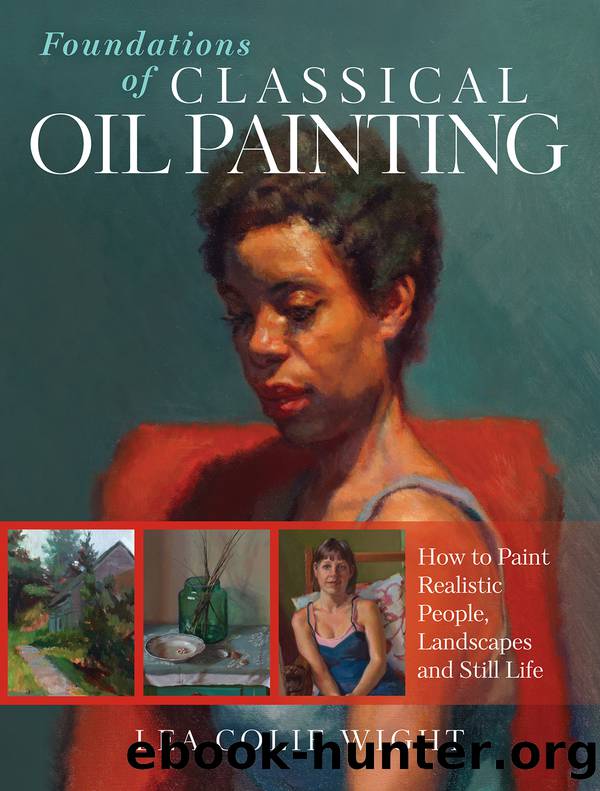Foundations of Classical Oil Painting: How to Paint Realistic People, Landscapes and Still Life \( PDFDrive.com \).mobi by Lea Wight

Author:Lea Wight
Language: eng
Format: mobi
Publisher: F+W Media
Published: 2020-04-30T14:22:15.212579+00:00
5 EVALUATE YOUR PROGRESS
Make several passes around your painting, always standing back and quickly moving your eye from one area to another. Do your color mixing directly on the painting, not on your palette. This ensures that you donât underestimate the impact of the color youâre trying to replicate and prevents second guessing. If you have trouble adjusting your paint color because you have so much paint on your canvas, begin to dip into your mixed medium (stand oil and turpentine). Experiment with dancing the paint on top of your canvas and pushing in if you want to mix with the paint underneath. Notice that there is a heavy paint deposit on the canvas, which you can see in the areas that show glare from the camera. Once you can see no further adjustments to your six color areas, you are either done with the color study or you can decide to break your masses into further divisions. In the pumpkin study I decided to move on to finding a highlight color on the pumpkin and also a plane change or dark light area in the light side of the pumpkin.
It is essential that you have a long filbert as the color study progresses so you can regulate how much paint you put on and whether it is deposited correctly on your canvas. If youâre working with a short bristle brush, it can push the paint away rather than deposit it on.
Download
This site does not store any files on its server. We only index and link to content provided by other sites. Please contact the content providers to delete copyright contents if any and email us, we'll remove relevant links or contents immediately.
| Landscape | Oil Painting |
| Portraits | Still Life |
| Watercolor | Acrylics |
Learn Drawing Quickly by Sharon Finmark(2520)
The Husband's Secret by Liane Moriarty(2505)
Drawing and Painting Birds by Tim Wootton(2438)
The Unlikely Pilgrimage of Harold Fry by Rachel Joyce(2216)
Classical Drawing Atelier by Juliette Aristides(2041)
The Art of Creative Watercolor by Danielle Donaldson(1777)
One Drawing A Day by Veronica Lawlor(1767)
Oil Painting For Dummies by Anita Marie Giddings & Sherry Stone Clifton(1705)
Post-Impressionism by Nathalia Brodskaya(1677)
Hieronymus Bosch by Virginia Pitts Rembert(1631)
Elizabeth Is Missing by Emma Healey(1611)
Special Subjects: Basic Color Theory by Patti Mollica(1566)
Anywhere, Anytime Art: Crayon by Monika Forsberg(1557)
Woman's Mysteries by Esther Harding(1499)
Memory's Wake by Fenech Selina(1441)
Fundamentals of Drawing by Barrington Barber(1296)
Chinese Brush Painting by Jane Evans(1248)
Acrylic Fusion by Dan Tranberg(1247)
Landscape Painting in Pastel by Elizabeth Mowry(1246)
